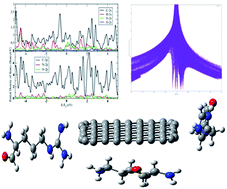Interactions, electronic and optical properties of nanographene–peptide complexes: a theoretical study†
Abstract
We studied the interaction of planar phenylalanine (phe), tryptophan (try), tyrosine (tyr); amide asparagine (asn) and glutamine (gln); arginine (arg) side-chains, charged histidine (his-c) and charged lysine (lys-c) side-chains on a nanographene (g) surface by Density Functional theory (DFT) and Time Dependent Density Functional Theory (TDDFT). The occupied number of states by the system at each energy level and relative contribution of a particular atom/orbital has been studied by Density of States (DOS) and Partial Density of States (PDOS) respectively. Atom-in Molecules (AIM) analysis and non-covalent interaction (NCI) PLOT are used to study the interactions in these complexes. The absorption spectra and HOMO–LUMO (HL) gaps are quantitatively analysed to study the correlation between the optical properties of the studied complexes. The HL gap of peptides is larger than the HL gap of graphene–peptide complexes, indicating strong interactions. All the peptides interact from the above the nanographene surfaces. garg, glys-c, gtry and gtyr complexes have smaller bond distance as compared to gasn, ggln, ghis-c and gphe complexes. AIM analysis and (NCI) PLOT showed noncovalent interactions for these complexes. TDDFT calculations indicated the applicability of these complexes as biosensors.



 Please wait while we load your content...
Please wait while we load your content...